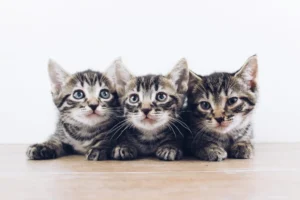Cats are infamous for their unpredictable behavior, often leaving their owners puzzled by their mood swings. One moment they’re affectionate and cuddly, and the next they’re aloof and standoffish. But why are cats so bipolar?
Cats’ mood swings may be attributed to a variety of factors, including their natural instincts, environment, and even their individual personalities. Understanding the reasons behind their unpredictable behavior can help cat owners navigate their feline friends’ emotions more effectively.
Feline Instincts: Unraveling the Mystery
Have you ever wondered why cats can seem so bipolar at times? Well, it all boils down to their feline instincts. Cats are natural hunters, and even though they may not need to hunt for survival in your cozy home, that predatory instinct is still very much alive. This can lead them to exhibit sudden mood swings, as they may feel the need to stalk and pounce on anything that moves, whether it’s a toy or your foot under the blanket.
Moreover, cats are fiercely territorial creatures. Any perceived threat to their territory, whether it’s a new pet in the household or even just a change in furniture arrangement, can trigger aggressive or moody behavior. So, next time your cat goes from purring contentedly to swatting at your hand in a matter of seconds, remember, it’s all in their instinctual nature.
Environmental Factors: The Influence of Surroundings
While feline instincts play a significant role in cats’ mood swings, environmental factors can also greatly impact their behavior. Cats are creatures of habit, and any disruption to their routine can throw them off balance. Whether it’s a change in feeding schedule or even a loud thunderstorm outside, these external stressors can leave your cat feeling on edge and more prone to mood swings.
Additionally, introducing a new pet or family member to the household can be a huge source of stress for cats. They may feel threatened or simply overwhelmed by the change, leading to anxiety and shifts in behavior. Remember, cats thrive on stability and familiar surroundings, so any disruption can cause them to act out.
Tips to Help Your Cat Stay Balanced
- Maintain a consistent routine: Cats thrive on predictability, so try to stick to a regular feeding and play schedule.
- Provide plenty of hiding spots: Cats feel safest when they have places to retreat to, so make sure they have cozy hideaways.
- Use pheromone diffusers: Calming pheromones can help reduce stress and anxiety in cats.
- Ensure plenty of mental and physical stimulation: Engage your cat with interactive toys and play sessions to prevent boredom and frustration.
- Consult a veterinarian if behavior changes persist: If your cat’s mood swings seem extreme or prolonged, it’s always a good idea to seek professional advice.
Personality Traits: The Role of Individuality
Cats are known for their unique personalities, just like humans. Each cat has its own set of quirks, preferences, and behaviors that contribute to their overall demeanor. This individuality plays a significant role in why cats can seem so bipolar at times. Some cats may be more sensitive to changes in their environment, while others may be more laid-back and adaptable.
Understanding your cat’s individual personality traits is crucial in deciphering their mood swings. Pay attention to how your cat reacts to different situations, whether they enjoy being petted or prefer their alone time, and how they interact with other pets in the household. By recognizing these unique characteristics, you can better anticipate and manage your cat’s mood fluctuations.
Body Language Decoded: Understanding Cat Communication
Cats are masters of communication, using subtle cues and body language to convey their feelings. Learning to decipher these signals can help you better understand why your cat may be acting in a certain way. For example, a cat with flattened ears and dilated pupils may be feeling scared or threatened, leading to sudden mood changes.
Pay attention to your cat’s tail movements, ear positions, and overall body posture to gauge their emotional state. Purring, meowing, or hissing are also forms of communication that can indicate how your cat is feeling. By tuning into these cues, you can better navigate your feline friend’s mood swings and provide the necessary support and care.
Key Insight: Cats have a wide range of vocalizations, each serving a different purpose. From chirps and trills to yowls and growls, these sounds can give insight into your cat’s mood and needs. By paying attention to their vocal cues, you can better address their emotions and alleviate any potential mood swings.
Play Therapy: Techniques to Manage Mood Swings
Hey there, cat lover! If you’re wondering why your feline friend seems to have mood swings, don’t worry, you’re not alone. Cats can be quite sensitive creatures, and just like us humans, they can have their ups and downs. One effective way to help your cat manage these mood swings is through play therapy.
Engage in Interactive Play: Cats are natural hunters, so engaging them in interactive play sessions can help release excess energy and reduce stress. Try using toys like feather wands or laser pointers to get them moving and mentally stimulated.
Create Enrichment Activities: Setting up puzzle feeders or hiding treats around the house can provide mental stimulation for your cat, keeping them engaged and happy. This can help alleviate boredom and prevent mood swings.
Rotate Toys: Cats can get bored with the same toys over time. Rotate their toys regularly to keep things interesting and prevent them from losing interest. This can help maintain their mental and emotional well-being.
Establish Routine: Cats thrive on routine, so setting a consistent feeding and play schedule can help create a sense of security and stability for your furry friend. Predictability can ease anxiety and reduce mood swings.
Remember, play therapy is a fun and effective way to bond with your cat while helping them manage their mood swings. So grab a toy and let the good times roll!
Seeking Veterinary Advice: When to Consult a Professional
Hey there, pet parent! While some mood swings in cats are normal, there are times when it’s essential to seek professional advice from a veterinarian or animal behaviorist. If you notice severe mood swings or drastic changes in your cat’s behavior, it’s crucial to address these issues promptly.
Sudden Aggression: If your cat displays sudden aggressive behavior towards you or other pets in the household, it’s a red flag that something may be wrong. Consulting a vet can help identify any underlying health issues or behavioral problems causing this behavior.
Excessive Hiding: Cats are known for their love of hiding spots, but if your cat starts hiding excessively or isolating themselves for extended periods, it could indicate stress or anxiety. Seeking professional advice can help uncover the root cause of this behavior.
Unexplained Lethargy: If your typically active cat becomes lethargic and shows no interest in playing or exploring, it could be a sign of an underlying health issue. A vet can conduct a thorough examination to rule out any medical conditions affecting your cat’s well-being.
Abrupt Changes in Eating Habits: Cats are creatures of habit when it comes to food. If your cat suddenly stops eating or has a significant change in appetite, it’s essential to consult a vet to rule out any health issues causing these changes.
Remember, your cat’s well-being is a top priority, so don’t hesitate to seek professional advice if you notice any concerning behavior. Your furry friend deserves the best care possible!
Fun Facts About Feline Behavior
Cats, with their mysterious and enigmatic personalities, can often exhibit what appears to be bipolar behavior. However, it’s essential to understand that cats are not actually diagnosed with bipolar disorder like humans. Instead, their mood swings are often influenced by a variety of factors. One interesting fact about feline behavior is that cats have a strong sense of independence and can switch from being affectionate to aloof in a matter of seconds. They are also territorial creatures, which can contribute to their unpredictable behavior at times. Understanding and respecting their need for personal space is crucial in forming a harmonious bond with your feline friend.
Dealing with a cat’s mood swings can be challenging, but patience is key when it comes to building a strong relationship with your feline companion. Cats are sensitive creatures that can be easily stressed by changes in their environment or routine. By being patient and understanding their unique needs, you can help reduce their anxiety and create a more stable and contented atmosphere for your cat. Remember, forming a bond with a cat takes time and effort, but the rewards of a loving and trusting relationship are well worth it.
Quick Tips for Understanding Your Cat’s Behavior:
- Observe their body language: Cats communicate through their body language, so pay attention to their tail, ears, and eyes to gauge their mood.
- Provide mental stimulation: Engage your cat in play and provide interactive toys to keep them mentally stimulated and prevent boredom.
- Establish a routine: Cats thrive on routine, so try to maintain a consistent schedule for feeding, playtime, and rest.
- Create safe spaces: Cats need a quiet and secure place to retreat to when they feel overwhelmed or stressed.
- Consult a veterinarian: If your cat’s mood swings are extreme or sudden, it’s essential to consult a vet to rule out any underlying medical issues.
By taking the time to understand your cat’s behavior and needs, you can navigate their mood swings with patience and compassion, leading to a happier and more harmonious relationship between you and your feline companion.
Alex, a passionate animal lover, has experience in training and understanding animal behavior. As a proud pet parent to two dogs and three cats, he founded AnimalReport.net to share insights from animal experts and expand his knowledge of the animal kingdom.









